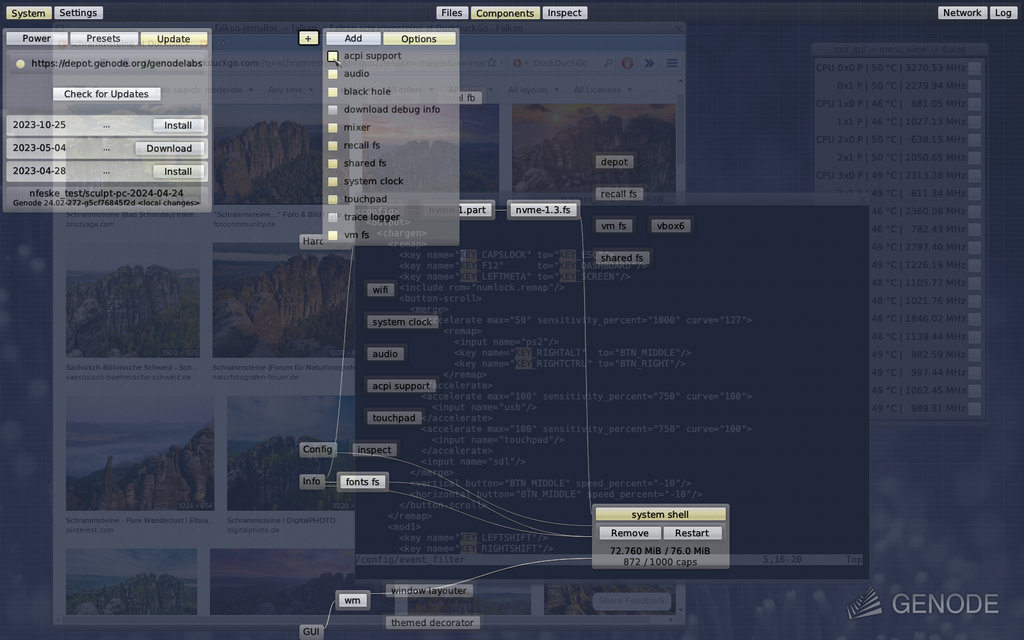| Gradient | Blog | X(Twitter) | Discord | Arxiv
- [2025/10] 🔥 Parallax version 0.0.1 has been released!
A fully decentralized inference engine developed by Gradient. Parallax lets you build your own AI cluster for model inference onto a set of distributed nodes despite their varying configuration and physical location. Its core features include:
- Host local LLM on personal devices
- Cross-platform support
- Pipeline parallel model sharding
- Dynamic KV cache management & continuous batching for Mac
- Dynamic request scheduling and routing for high performance
The backend architecture:
- Python>=3.11.0,<3.14.0
- Ubuntu-24.04 for Blackwell GPUs
Below are installation methods for different operating systems.
| Windows | ✅️ | Not recommended | Not recommended |
| Linux | ❌️ | ✅️ | ✅️ |
| macOS | ❌️ | ✅️ | ❌️ |
- For Linux/WSL (GPU):
- For macOS (Apple silicon):
We recommend macOS users to create an isolated Python virtual environment before installation.
Next time to re-activate this virtual environment, run source ./venv/bin/activate.
- Extra step for development:
Click here to get latest Windows installer.
After installing .exe, right click Windows start button and click Windows Terminal(Admin) to start a Powershell console as administrator.
❗ Make sure you open your terminal with administrator privileges.
- Start menu: Right‑click Start and choose “Windows Terminal (Admin)”, or search “Windows Terminal”, right‑click the result, and select “Run as administrator”.
- Run dialog: Press Win+R → type wt → press Ctrl+Shift+Enter.
- Task Manager: Press Ctrl+Shift+Esc → File → Run new task → enter wt → check “Create this task with administrator privileges”.
- File Explorer: Open the target folder → hold Ctrl+Shift → right‑click in the folder → select “Open in Terminal”.
Start Windows dependencies installation by simply typing this command in console:
Installation process may take around 30 minutes.
To see a description of all Parallax Windows configurations you can do:
For Linux+GPU devices, Parallax provides a docker environment for quick setup. Choose the docker image according to the device's GPU architechture.
| Blackwell | RTX50 series/B100/B200... | docker pull gradientservice/parallax:latest-blackwell |
| Ampere/Hopper | RTX30 series/RTX40 series/A100/H100... | docker pull gradientservice/parallax:latest-hopper |
Run a docker container as below. Please note that generally the argument --gpus all is necessary for the docker to run on GPUs.
The container starts under parallax workspace and you should be able to run parallax directly.
We will walk through you the easiest way to quickly set up your own AI cluster
First launch our scheduler on the main node, we recommend you to use your most convenient computer for this.
- For Linux/macOS:
- For Windows, start Powershell console as administrator and run:
When running parallax run for the first time or after an update, some basic info (like version and gpu name) might be sent to help improve the project. To disable this, use the -u flag:
Open http://localhost:3001 and you should see the setup interface.
Select your desired node and model config and click continue.
Copy the generated join command line to your node and run. For remote connection, you can find your scheduler-address in the scheduler logs.
You should see your nodes start to show up with their status. Wait until all nodes are successfully connected, and you will automatically be directed to the chat interface.
When running parallax join for the first time or after an update, some basic info (like version and gpu name) might be sent to help improve the project. To disable this, use the -u flag:
Done! You have your own AI cluster now.
You can access the chat interface from any non-scheduler computer, not just those running a node server. Simply start the chat server with:
After launching, visit http://localhost:3002 in your browser to use the chat interface.
First launch our scheduler on the main node.
For example:
Please notice and record the scheduler ip4 address generated in the terminal.
For each distributed nodes including the main node, open a terminal and join the server with the scheduler address.
For example:
Developers can start Parallax backend engine without a scheduler. Pipeline parallel start/end layers should be set manually. An example of serving Qwen3-0.6B with 2-nodes:
- First node:
- Second node:
Call chat API on one of the nodes:
For macOS or Linux, if you've installed Parallax via pip and want to uninstall it, you can use the following command:
For Docker installations, remove Parallax images and containers using standard Docker commands:
For Windows, simply go to Control Panel → Programs → Uninstall a program, find "Gradient" in the list, and uninstall it.
| DeepSeek | Deepseek | DeepSeek-V3.1 DeepSeek-R1 DeepSeek-V3 DeepSeek-V2 |
DeepSeek V3.1: The New Frontier in Artificial Intelligence | "DeepSeek" is an advanced large language model series from Deepseek AI, offering multiple generations such as DeepSeek-V3.1, DeepSeek-R1, DeepSeek-V2, and DeepSeek-V3. These models are designed for powerful natural language understanding and generation, with various sizes and capabilities for research and production use. |
| MiniMax-M2 | MiniMax AI | MiniMax-M2 | MiniMax M2 & Agent: Ingenious in Simplicity | MiniMax-M2 is a compact, fast, and cost-effective MoE model (230B parameters, 10B active) built for advanced coding and agentic workflows. It offers state-of-the-art intelligence and coding abilities, delivering efficient, reliable tool use and strong multi-step reasoning for developers and agents, with high throughput and low latency for easy deployment. |
| GLM-4.6 | Z AI | GLM-4.6 | GLM-4.6: Advanced Agentic, Reasoning and Coding Capabilities | GLM-4.6 improves upon GLM-4.5 with a longer 200K token context window, stronger coding and reasoning performance, enhanced tool-use and agent integration, and refined writing quality. Outperforms previous versions and is highly competitive with leading open-source models across coding, reasoning, and agent benchmarks. |
| Kimi-K2 | Moonshot AI | Kimi-K2 | Kimi K2: Open Agentic Intelligence | "Kimi-K2" is Moonshot AI's Kimi-K2 model family, including Kimi-K2-Instruct and Kimi-K2-Instruct-0905. The models are designed for agentic intelligence and available in different versions and parameter sizes. |
| Qwen | Qwen | Qwen3-Next Qwen3 Qwen2.5 |
Qwen3-Next: Towards Ultimate Training & Inference Efficiency | The Qwen series is a family of large language models developed by Alibaba's Qwen team. It includes multiple generations such as Qwen2.5, Qwen3, and Qwen3-Next, which improve upon model architecture, efficiency, and capabilities. The models are available in various sizes and instruction-tuned versions, with support for cutting-edge features like long context and quantization. Suitable for a wide range of language tasks and open-source use cases. |
| gpt-oss | OpenAI | gpt-oss | Introducing gpt-oss | "gpt-oss" refers to OpenAI's open-source GPT models, including gpt-oss-20b and gpt-oss-120b. The number (e.g., 20b, 120b) indicates the parameter count (20 billion, 120 billion). |
| Meta Llama 3 | Meta | Meta Llama 3 Llama 3.1 Llama 3.2 Llama 3.3 |
Introducing Meta Llama 3: The most capable openly available LLM to date | "Meta Llama 3" is Meta's third-generation Llama model, available in sizes such as 8B and 70B parameters. Includes instruction-tuned and quantized (e.g., FP8) variants. |
.png)











